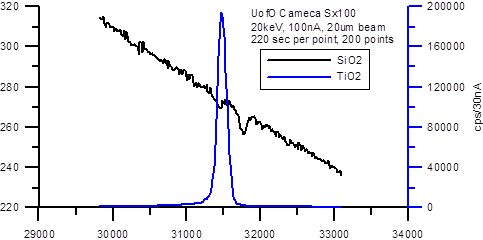Use Blank Calibration Sample Trace Element Accuracy Corrections
This option will globally turn on or off the assigned blank correction parameters (see Standard Assignments dialog under the Analyze! window) to quickly evaluate the effect of the quantitative iterated blank correction.
The blank correction is a powerful method to improve the accuracy of trace elements (and because it is fully matrix corrected can even be applied in the case of oxygen analyses for water by excess oxygen). The following example demonstrates the application of the blank correction to a Ti in quartz analysis.

For example, spectrometer analyzing crystals have secondary lattice reflection planes which will produce small artifacts (“holes”) in the spectrum, some directly underneath the analytical peak (depending on the mounting orientation). This produces a systematic accuracy error in trace element analyses that can easily exceed the precision of the measurement even with moderate beam current and count times.
ELEM: Ti Ti Ti Ti Ti Si O SUM
XRAY: (ka) (ka) (ka) (ka) (ka) () ()
428 -.00023 .00029 .00005 .00076 -.00061 46.7430 53.2572 100.000
429 -.00023 -.00003 -.00001 -.00009 .00022 46.7430 53.2569 99.9998
430 -.00010 .00002 -.00011 -.00003 .00045 46.7430 53.2572 100.000
431 .00016 -.00007 -.00009 -.00035 .00037 46.7430 53.2570 100.000
432 .00019 -.00029 .00002 -.00016 -.00037 46.7430 53.2566 99.9990
AVER: -.00004 -.00002 -.00003 .00003 .00001 46.7430 53.2570 99.9999
SDEV: .00020 .00021 .00007 .00043 .00047 .00000 .00024
UNCT: -.1 .0 -.1 .0 .0 .0 .0
KRAW: .00000 .00000 .00000 .00000 .00000 .00000 .00000
PKBG: .99857 .99949 .99907 1.00219 1.00050 .00000 .00000
BLNKL: .000000 .000000 .000000 .000000 .000000 ---- ----
BLNKV: -.00043 -.00009 -.00053 .000039 .000704 ---- ----
By measuring the systematic offset (blank value line “BLNKV”) on a “blank” standard which contains a zero, or known non-zero level (“BLNKL”) for the element of interest in a similar matrix one can subtract the corresponding intensity from the sample during the matrix iteration for a rigorous treatment of all data including the k-ratio and P/B calculations.